The Ronn Burke Story
Part 1
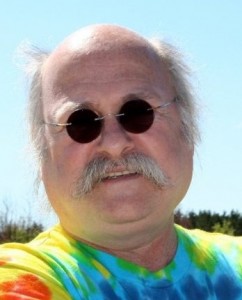
Ronn Burke was born in Grand Rapids on June 1, 1951
He is a totally self-trained musician and recognized by his peers as one of the most talented and refined singers from Grand Rapids.
He also plays a wide variety of instruments including tenor and baritone ukulele, piano, 6 & 12 string electric and acoustic guitar, bass guitar, and drums. He is well known in West Michigan for his lengthy tenure with Natchez Trace, which dates back to 1972. Yet he has actually been deeply involved with music since he was in elementary school and lived at 238 Travis N.E., in Grand Rapids.
As a fifth grader at Palmer Elementary, performed with classmate Bob Vogel (current band leader and lead guitarist for Loretta Lynn). Their teacher, Mr. Russell McClean, had a significant musical influence on both boys. When McClean played the ukulele for their class, it encouraged them to learn how to play this instrument as well as enter and win the school talent contest. McClean worked with Ronn and Bob to teach them a few things and encouraged them to rehearse. Sometimes they did this during recess. That same year they performed for the Lowell Showboat audience with their group called the Combos, which also included Keith Smith and Dennis Bresnahan. While in Lowell, Ronn saw a rock band perform and decided that he would like to play the same type of music in the near future. The Combos stayed together for at least a year and performed at various school functions as well as at the Peninsular Club.
“THE COMBOS”
About this same time, Ronn received a Stella acoustic guitar from his father. He purchased the guitar at a bar that was part of his delivery route for West Side Beer Distributing, and brought it home to surprise Ronnie. His first electric guitar was a cherry- red Gibson Les Paul, Jr. When he was twelve, it was stolen out of his aunt’s car while they were attending a wedding in Chicago. But there were to be many other guitars for Burke as the years proceeded.
Like numerous other boys growing up in the early 1960s, Ronn spent much of his spare time refining his guitar playing as well as singing the songs that were popular at that time.
By the time he was in the eighth grade in 1965, he became involved with his first rock and roll band called the Laymen. Robin Nott, a drama teacher with the Gun Lake secondary school system and also a skilled guitarist, clearly recalls who the members of the Laymen were, their respective instruments and a bit of their band history:
“I was with Ronn Burke from 8th grade to 10th grade in The Laymen. Members were Ronn Burke on guitar and vocals, Robin Nott on Danelectro “tulip” bass, Brad Kick on guitar and vocals, John Throckmorton on compact Farfisa organ and vocals, and Clayton Jones on “blue-sparkled” Ludwig drums.”
“Cupid and the Intrepids were our rival Junior High garage band, and we’d meet them at various battle of the bands around town. They were from the upper east-side of Grand Rapids. I don’t remember any of their names, but they were pretty good.”
In 1966, Ronn switched to Tanglewood which included Roger Rosema (bass), Rick Sherwin (guitar and vocals), and Tim Waltcheski on drums. This band survived until the mid 70s, although Ronn had left during 1967. In the early 1970s, Tanglewood featured the voice and guitar playing of Charlie Huhn, who presently performs the same functions for Foghat. Charlie was also a member of Ted Nugent’s band from 1978-1982, and has performed with Gary Moore and Humble Pie, as well.
Burke states that Tanglewood’s first engagement was at the grand opening of Albert’s Shoes at Woodland Mall, and that they performed the Beatle’s hit, “Ticket to Ride.”
His next move was to join the Jujus, a band that was already well established in West Michigan and had recorded songs that were receiving regular airplay on local radio stations.
The following excerpt from a JuJus’ biography, written by Chas Kit from his “Garage Hangover “ website, explains the context in which Ronn became a member in 1967:
“The JuJus first 45 featured two Ray Hummel originals, the amazingly powerful ‘You Treat Me Bad’ and the fifties-sounding ‘Hey Little Girl.’ The record sold well locally, supposedly reaching #2 on a chart in western Michigan in October, 1965. The future looked good and Drummond Records of Detroit offered Ray Hummel a contract based on his songwriting. The band couldn’t sign because newly-married Ray refused to tour out of state, and Ray soon left the band. “
“The JuJu’s made several personnel changes before making their next record. Brett Wells came in on vocals, and Bruce Essex, who had played guitar with Rick Stevens in the Paeans joined for part of 1966. Then Max Colley left and Bill Gorski was drafted, so the band found guitarist Ron Burke and drummer Ron Homrich. Before long Brett left and Ron Burke took over on vocals.”
“In the summer of ’67 their manager Jim Geeting opened The Island, a teen club in Ludington, in which the JuJu’s played regularly and supported touring national acts like the Kingsmen and the Electric Prunes. By this time the band had a tougher rock sound. “ ……“In late 1967 the band broke up as Rod Shepard and Rick Stevens went into the military.” “
(See: http://www.garagehangover.com/?q=JuJus to read this complete article)
Burke, who was under the legal age of 18 at this time, used his friend’s (Mike Butler’s) draft card for fake identification to gain admission into the bars and nightclubs that the Jujus played at.
Ronnie’s musical contributions with the Jujus are preserved on their anthology CD named “You Treat Me Bad.” Ronn wrote and sang two songs included on this release that are entitled “In the Park” and “Sometime or Other.” (This CD project was compiled and produced by Michael Greisman and Rod Shepard, © (p) 2009; Cicadelic Records)
Further applying his recent experience of recording and songwriting for the Jujus, he created his first 45 rpm record at Cinema Sound, with Denny Cuson as the engineer. The studio was located near Burton on Division. The songs he wrote for this session were entitled “You Can Only Be Just What You Are” and “It’s Not Easy.” It was released on the Powerhouse label. The record was produced by Johnny Powers and Roger Bass. Burke knew Johnny Powers. He was doing some recording with Ronnie Fray at the same time Burke was recording this single. He played acoustic guitar and sang all the vocal parts. A string quartet from Michigan State University was used at the session and the string arrangements were created by Roger Bass, who also played piano on the tracks.
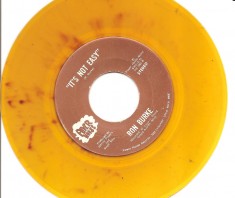
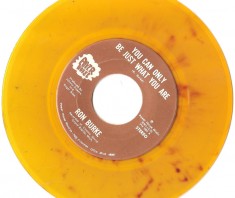
Though the Jujus disbanded, Burke retained Jim Geeting as his manager. Ronn has pleasant memories of working with Jim, and maintains that he was a good person that was a bit older than him, was fun-loving and always busy creating new situations that kept Burke working. While still in the Jujus, before Ronn had his driver’s license, Jim would even drive him to rehearsals.
At the Town House, a restaurant and motel once located north of the downtown post office on Monroe, Jim booked a solo engagement for Ronn at the motel bar called “The Monastery.” Ronn recalls that the motel was being reconstructed at that time, and that a tool shed located behind the bar had electricity and a TV in it, and that he used the shed to relax between sets.
During 1968 and the following year, Ronn joined forces with The Boyfriends, comprised of the drummer and band originator Dick Webster, , guitarist Gary Johnson, Jim Ranta on keyboards, and Paul Magnan on bass.
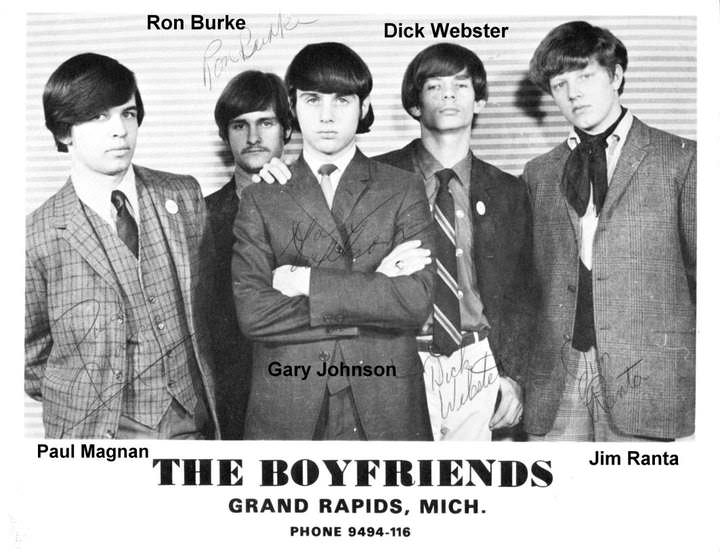
Paul Magnan recalls: “I believe we played “The Place” at least once. I think we won a battle of the bands there. If I remember correctly, there was another band that played there that had some older members that were usually playing at local bars. Don’t know why they were competing, but they were not happy when we won.”
Ronn also played with a band named Hyde Park after leaving The Boyfriends, around 1969.
In 1971, Burke joined Ronnie Fray’s band. The other band members were Dale “Dusty Chaps” Thomas, Randy Panda and Tom “Crow.” The friendship and musical ties that developed with Fray were an influence in terms of initiating a change of direction in Burke’s music. Up to this time, he was primarily playing rock music. Though Fray could play almost any type of music, he displayed strong country music influences well before Burke hooked up with him. At that time, Fray and Burke were both in tune with a new trend in music. “County- rock” recordings had already entered the market, and this era kicked into high gear in May of 1972, due to the popularity of the Eagles hit named “Take It Easy.” It’s safe to say that Fray and Burke were and still are proponents of the country rock style, even though both can play just about any type of music.
Ronnie Fray remembers that “when Ronn Burke played and sang with us is Alabama and Michigan, it was always such a pleasure to hear his voice…and harmonies. He played guitar and bass with us…and that particular band was probably one of the best groups of musicians I ever had the great pleasure to work with…What a band!”
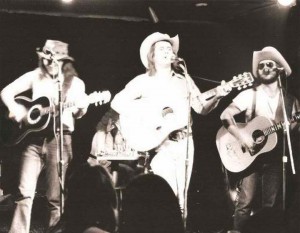
THE ORIGINAL 'NATCHEZ TRACE' - KEVIN RADICKE - DAN PARSONS AND RONN BURKE....WOW - WHAT A GREAT TRIO
In 1972, while Ronn was in Alabama with Ronnie Fray’s band, the group split up. Burke joined a band named Natchez Trace that was already formed, and it included Dan Parsons, John Egger and Sonny Brewer. In 1973, Burke returned to Grand Rapids with Parsons, Egger and Brewer were they recorded a single with the songs “I Miss Mississippi,” written by Ronnie Fray, and “Old 55” on it, recorded at Cinema Sound in Grand Rapids. It was issued on the Ultra-Promo label and heard regularly on Grand Rapids radio stations. Eventually Natchez Trace was slimmed down to a trio format that included Dan Parsons and Kevin Radeke. It is this trio that many locals consider to be the original Natchez Trace, although it was not.
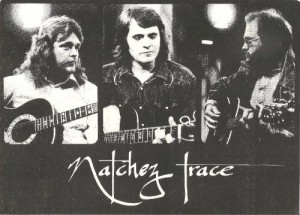
Natchez Trace Record Cover "I Miss Mississippi" Dan Parsons, Kevin Radeke, Ronn Burke
Due to the popularity of their recording and the mellow appeal of their vocal harmonies, the Natchez Trace trio became a popular West Michigan band, and was invited to perform at the WLAV Raft Race. Ronn claims this is the largest crowd that he has performed for, with possibly as many as 20,000 listeners.
Around 1974, Ronn decided to move to California with Natchez Trace. Accompanying him were Billy and Buddy Chrysler, Roger Matthews, Dan Parsons, Kevin Radecki and Ed Kettle, their manager. Everyone’s mission was to hook up Natchez Trace with a major record label. Asylum Records was targeted. At that time Asylum had The Eagles, Linda Ronstadt, Joni Mitchell and Jackson Brown under contract. Martin Coen, the attorney for this label liked Natchez Trace but suspected that there were already too many bands that were “similar” to Natchez Trace at that time.
Initially, the band stayed with friends in South Pasadena then moved to the San Fernando Valley. It was there that they lived next door to a man who happened to be a friend of actor James Caan. It was a friendly neighborhood, and their neighbors helped the band by supplying food while they were low on funds. Family and friends were sending care packages from home. The band wasn’t working a lot. Then Kevin moved out and was hard to get in contact with for their occasional engagements.
Yet, while they were in California they performed at popular venues like The Troubadour, The Palomino, The Ice House, The Red Onion in Long Beach (which was owned by Glen Campbell) and the Red Onion on Rodeo Drive, in Brentwood. They also played at The Corral in Topanga Canyon, a place that the Everly brothers liked to frequent.
They also played at showcases for movie stars who were opening nightclubs. John Fogerty had started a new record label and liked the band but they decided to hold out for a more established recording company. Finally, they ran out of money and headed back to Grand Rapids.
Upon returning to Grand Rapids in 1975 they created a new “electrictrified” version of Natchez Trace that included Buddy on drums, Ronn and Dan on guitars and Bob Riley on bass.
Part 2
After returning to Grand Rapids from California in late 76 or early 77, Natchez Trace altered their instrumentation. In the past, acoustic guitars were the fundamental part of their sound. With the addition of a rhythm section including Buddy Chrysler (previously with Tanglewood and Xebec) on drums and ex-Common People bassist Bob Reilly, the band could now more closely replicate the “electric” sound of current country-rock music. During the course of his career, Burke occasionally changed styles of music with his bands, switched musicians and varied the musical instruments that were used. However, his dedication to vocal harmony has never wavered.
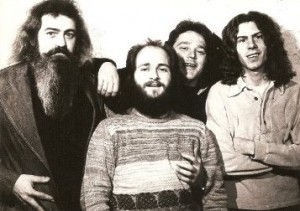
- Electric Natchez Trace (L-R) Bob Riley, Ronn Burke, Dan Parsons, Bud Chrysler, c.1977
This new “electric” version of Natchez Trace gained increased exposure by appearing on WOOD-TV’s Buck Matthews Show and performing at a country music concert at Grand Valley State College’s field house on April 1, 1977. This show also featured Heartsfield and headliner John Hartford.
Soon after the show at Grand Valley, Natchez Trace disbanded. At that time, Ronn and Bob Vogel worked together for a second time when he joined Dirk Rivers. Ronn and Bob had sung together at the age of 10 in “The Combos,” at the beginning of the 1960s. Bob Vogel: “Ronn approached me and asked if he could join Dirk Rivers. We began playing at the Mouse Trap on Bridge Street. After a while we hired Dan Parsons, too, formerly with Natchez Trace.”
Bob and his brother Dick, a drummer, formed Dirk Rivers in early 1974 with guitarist Jerry Davis and Kim Rush on bass. This original version of Dirk Rivers was clearly a rock and roll band. They played in clubs and at dances in Michigan and at Park City, Illinois. They also performed at concerts held at the Thunderchicken on Alpine in 1975, backing up James Gang, T. Rex and Rory Gallagher. When they broke up that same summer, Bob and his brother Dick restrained themselves temporarily by creating a “lounge band” trio with bassist Mike Grattan, which they called The Vogel Brothers. This project lasted for about a year until they decided to revive the Dirk Rivers Band. This new edition included guitarist Rick Brown and Bob Reilly on bass.
On April 21, 1979, Dirk Rivers played at Bea Baker’s Alpine Lounge, a bar that this band worked at regularly. Members at that time were Bob and Dick Vogel, Danny Parsons, John Fritz and Ronn Burke.
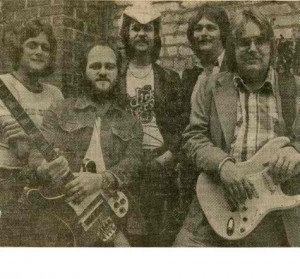
- Dirk Rivers
In late 1979 and early 1980, Ronn and the Dirk Rivers Band backed up Rick Nelson, Tanya Tucker, Doug Kershaw and the Ozark Mountain Daredevils at Paulo’s Living Room on South Division and 54th Street. They also played a show with Johnny Paycheck at the Civic Auditorium.
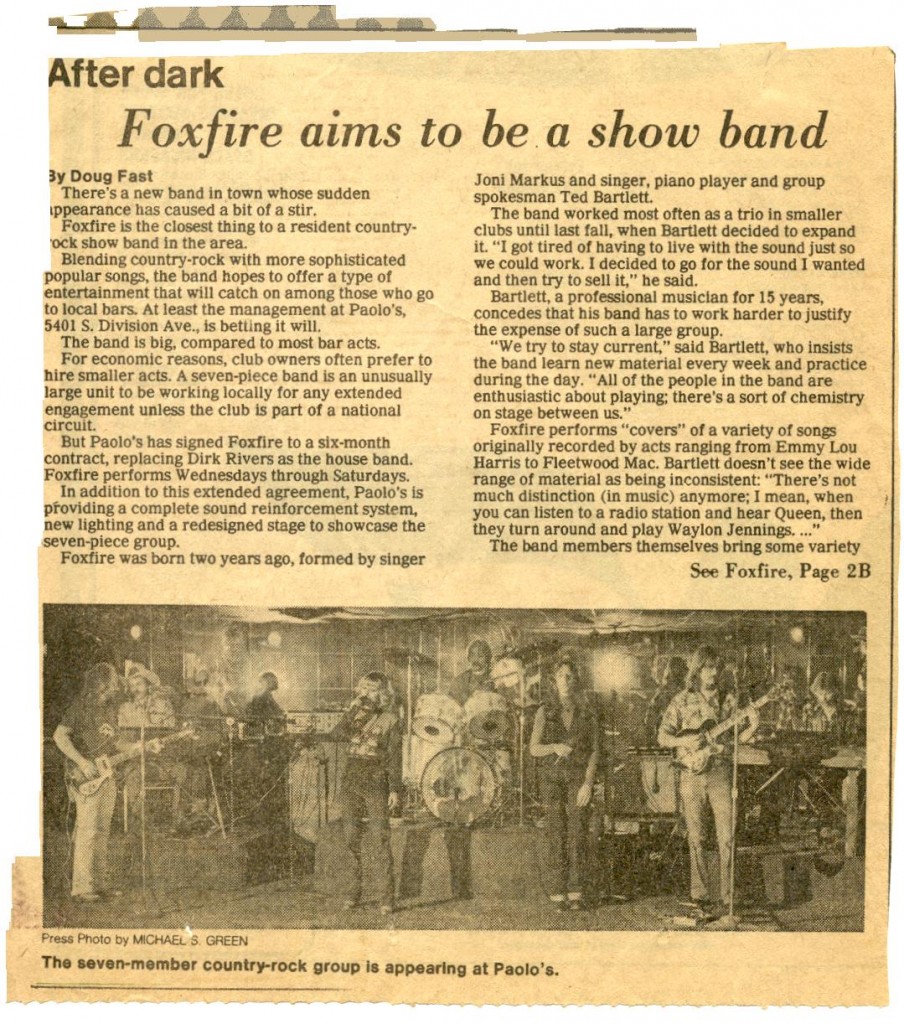 Ronn in Foxfire at Paulo’s Living Room, courtesy Grand Rapids Press, c.1980
Ronn in Foxfire at Paulo’s Living Room, courtesy Grand Rapids Press, c.1980
Ronn’s tenure with Dirk Rivers extended into 1984, other than a few months spent with a seven member country music “show band” named Foxfire in 1980. Burke replaced Doug Klein on bass when the group had already been working for a few months at Paulo’s Living Room. Veteran Grand Rapids musician Lin Nowicki (formerly with Lynn and the Invaders and Common People) sang for this band, as well as two other female singers, Patsy Stevens and Joannie Markus.
Probably the most significant part of Ronn’s involvement with Foxfire was the musical relationship that he created with guitarist/vocalist Steve Damstra. When Foxfire dismantled Ronn was certain that he wanted to continue working with Steve. Bob Vogel: “Dirk Rivers broke up shortly in 1980 and Ronn went with Foxfire. That band lasted about two seconds. When they broke up I asked Ronn to come back and he said he would if we also hired Steve Damstra. We did. That band won the local Wrangler Country Star Search at the Alibi (AKA Thunderchicken) on Alpine.” This was held in November and December of 1981, with fifty area bands competing. Initially, each of these bands played for either 15 minutes or 3 songs. The four best acts played five minutes each on December 6, 1981. The regional were held in Detroit. The national finals were held in April of 1982 in Nashville, Tennessee.
This incarnation of Dirk Rivers after Foxfire was a venture into country rock and “southern” rock music. But in 1983, while they were playing in Wisconsin, the band decided to change their musical format by covering current rock hits, though this was short lived.
In 1984 Steve and Ronn parted company with the Vogel brothers to revisit another acoustic guitar version of Natchez Trace with Kevin Radeke. Ronn Burke played bass guitar with this band. But this acoustic guitar format was not long lasting. In 1985, Tom Dever was added on drums, and they began to perform classic rock while retaining some of their lighter tunes. Steve Damstra recalls that during the Natchez Trace ‘rock band’ era, “we opened for Mitch Ryder and the Detroit Wheels, as well as Rare Earth.”
During the following year Kevin left Natchez Trace and was replaced by guitarist/vocalist John Andrews, formerly a fellow member of Horsefeather with Steve Damstra. This version of Natchez Trace became a “classic oldies” band, featuring cover versions of popular bands like the Beatles, Hollies and the Grassroots. They retained this style until 1995. Personnel changes during this phase included the departure of John Andrews, with Roger Matthews replacing him in 1988. Coincidentally, John returned in 1990 but left again in 1993 (replaced by Dave Clausen) and finally rejoined again in 1995 for the last three months of Natchez Trace as a rock band.
It is interesting to note that a DVD of a December 1988 Natchez Trace performance exists. In 1982 Doug Taylor, a Natchez Trace fan, bought a high quality Panasonic video camera and started video-taping bands that he liked. However, he was not satisfied with the lack of audio quality produced with the camera. While at a Natchez Trace performance, Doug asked Ronn Burke for permission to obtain quality recordings from their sound board as well as film the band in action.
Ronn consented and they set up the date to record at Russo’s Restaurant in Belding. Dickie Harris, their sound man, had worked for Ronnie Fray and many other local bands. Dickie mixed the audio perfectly that night, and the audio recording was given to Doug. Taylor did his best to film the performance, working around the dancers. Burke jokingly told the dancers to step on Doug if he got in their way. Doug succeeded in getting some good on-stage close-up shots of Natchez Trace as they performed that night, and he returned the following night to obtain additional footage.
Doug originally planned on editing the film and audio and presenting it to the band members as a finished product, but he maintained a hectic schedule designing and manufacturing pit-to- driver communications systems for professional auto racing teams across the country. Ronn and Steve Damstra kept asking Doug about the tapes, and Doug responded that the tapes were lost. After 21 years and a move to the Upper Peninsula in 2009, he found the tapes and proceeded to create a DVD product, which he presented to Ronn and Steve as a surprise gift. He called the DVD “The Natchez Trace Lost Tapes Album”. One song from this DVD can be found on You Tube at http://www.youtube.com/watch?v=q-dHoMQGQF8
In 1989 Ronn suffered a heart attack and spent some time recovering before returning to the band in 1990. Bob Vogel filled in on bass for one night so that Natchez Trace could honor a commitment. Stu Maynard was hired to play bass until Ronn was ready to come back. Stu left the band shortly after Ronn returned.
From 1995 to 1997, Natchez Trace again reverted to the acoustic guitar trio format. This version was known as “Natchez Trace Unplugged” and comprised of Ronn, Steve and newcomer guitarist/vocalist/ songwriter Max Morrison. Max was born in Shreveport, Louisiana in 1954, and moved to Grand Rapids in 1982. In addition to several other musical projects, Max had worked in Grand Rapids with singer Roberta Bradley for twelve years previous to joining Ronn and Steve. Max contends that during the years that he played with Ronn Burke, they never publicly performed the scores of songs that were composed by the band members.
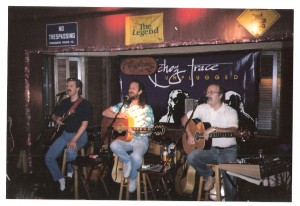
- (L-R) Steve Damstra, Max Morrison, Ronn Burke
In 1996, the trio functioned as the opening act for The Grassroots at a well-attended outdoor concert in Muskegon called Skyrockin’ 96. It was sponsored by the Pyrotechnics Guild International.
In 1997, Natchez Trace broke up when Steve Damstra decided to leave to pursue a solo career. Max and Ronn still played a few gigs together until Ronn joined a new band called Icon.
In 1998 through 1999, another trio was created by Max, Ronn and Robin Spring. They called it Triad. Robin was born into a significantly musical family. Her great grandfather, paternal and maternal grandfathers, her mother and her uncle were all musicians.
While Ronn was playing with Icon, Robin and Max were working with Keith Ayers in a trio named Song Bird. Max had also played with Robin in a group named Carom with Tone VanLente in 1994 before he joined Steve Damstra and Ronn in Natchez Trace in 1995. In 1996, Robin and Max were working with Roberta Bradley in a group named Pandora.
Triad’s last performance was on New Year’s Eve in 1999 at the Old Boy’s Brew Pub in Spring Lake. Max was also busy working with Roberta Bradley and Dan Giacobassi at the time that Triad broke up.
In 2000, Robin and Ronn created a duet entitled R & R Music Co. Later they called themselves R & R- Ronn and Robin. Robin states that R & R also stood for “restful and relaxing,” as their music was delivered in an acoustic and easy-going style, while capitalizing on their vocal harmonies. Ronn and Robin promoted this duet until late 2005, when Steve Damstra joined them. Their first engagement as a trio was in early 2006, when once again, they adopted the name of Natchez Trace, but there music was also suitably described as, “Natchez Trace Acoustic Classic Rock.”
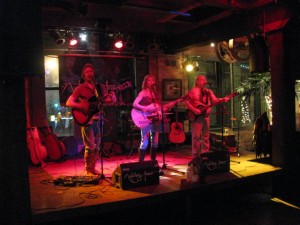
- Steve Damstra, Robin Spring, Ronn Burke
They performed at major Grand Rapids events such as the 4th of July downtown firework displays, Celebration on the Grand, Festival of the Arts, Art Prize, and opened for Jonathan Edwards and Joe Piscopo performances at the B.O.B. They also played at the Muskegon Summer Celebration and the Lowell Showboat celebration, as well as a huge rally which supported the election of Jennifer Granholm.
This group thrived until May of 2011 when Ronn decided that he wanted to start performing on his own and devote more time to the writing and performing of his own compositions. Ronn is also currently working on a book project about his career in music.
Written by Kim Rush and Doug Taylor
Credits:
Part 1 compiled by Ronn and Amy Burke with Kim Rush; with assistance from Robin Nott, Paul Magnan, Buddy Chrysler, Bob Vogel, Doug Taylor and Bob Reilly.
Part 2 compiled by Ronn and Amy Burke, Robin Spring, Steve Damstra, Max Morrison, Doug Taylor, Kim Rush, Bob and Dick Vogel, Bob Reilly, Buddy Chysler and Lin Nowicki.
Credits: Primarily compiled by Ronn and Amy Burke with Kim Rush; with assistance from Robin Nott and Paul Magnan, Bob Vogel and Doug Taylor. Also credits to Chas Kit for his article about the Jujus from his “Garage Hangover “ website. See: http://www.garagehangover.com/?q=JuJus
Ronnie Burke will be at Cheer’s on Plainfield in Grand Rapids on September 22nd, 8:30 – 11:30

2 Responses to Ronn Burke Story